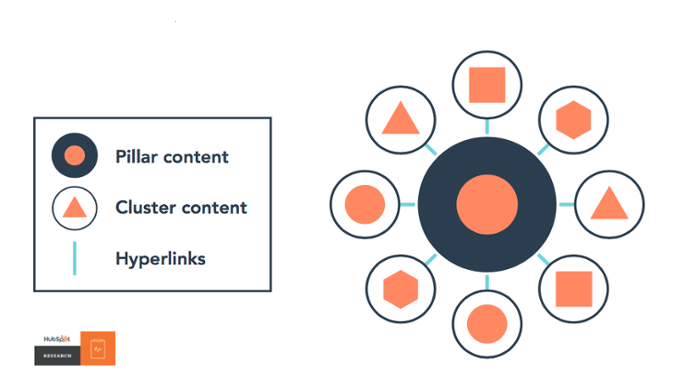Pillar Pages: A Content Marketing Powerhouse
By Jaco Grobbelaar on Mon, Aug 14, 2023 @ 05:00 AM


[This article was originally published in July 2022 and has been expanded and revised.]
There are few tactics for content marketing strategy a powerful today as the use of pillar pages for high-performing content on your site.
But knowing what makes for a quality pillar page and how to implement this power content tactic into your brand's marketing strategy can be challenging.
What is a Pillar Page? An Essential Question
On almost every business or corporate website, one will usually find a business blog that will contain a series of articles or, in some cases, videos. When executed properly these posts will be consistent, frequent, and the topics relevant to that brand's ideal market or audience.
In addition, websites will contain various other types of written content on each webpage found on the site.
Along with the "standard" information on a site's home page and "About" page, many websites contain various other pages containing additional content such as:
- Customer Success Stories or Case Studies
- White Papers
- Resource Centers
- Product Content and Guides
Most of this written content is regularly "crawled" and indexed by Google and other search engines. This is critical for producing what are known as organic search results, or SERPS - search engine results pages.
And pillar pages significantly improve search results ranking on Google.
As one firm pointed out, pillar pages are the absolute best way to capture high volume search terms on Google aside from paid Google AdWords.
So, what is a "pillar page" anyway?
A Pillar Page: "Content on Steroids"
Typically, a pillar page is published as a stand-alone page on a website. But what makes it so unique and powerful in terms of driving traffic to the site is its structure.
A pillar post, or page, is a comprehensive and in-depth piece of content that serves as a foundational resource on a specific topic. It's typically longer and more detailed than regular blog posts and aims to provide thorough coverage of a subject, addressing various aspects, subtopics, and related information.
HubSpot offers this definition of a pillar page:
"A pillar page covers all aspects of [a] topic on a single page, with room for more in-depth reporting in more detailed cluster blog posts that hyperlink back to the pillar page."
They also add that a pillar page is the basis on which a topic cluster is built. And a topic cluster is the "magic sauce" that is powered by the pillar page.
The pillar page strategy is often used as part of a broader content marketing strategy to help establish authority, drive traffic, and engage an audience.
Pillar pages can attract backlinks from other websites, improve search engine rankings, and act as a central hub from which you can link to shorter, more focused blog posts (often known as "a content cluster") that delve into specific aspects of the main topic.
Instead of online searchers finding somewhat random results in response to a query - a blog post here, a resource page there - a website hosting a structure known as "topic cluster" anchored to a pillar page will help searchers find information on your site more easily.
It accomplishes this by organizing and linking your site's URLs together to help more pages on your site rank in Google.
What Makes for a Great Pillar Page?
Key characteristics of a pillar post include:
- Comprehensive Content: The pillar post should cover the topic comprehensively, offering a detailed exploration of the subject matter.
- Evergreen Content: Pillar posts are intended to remain relevant over time, so they should focus on evergreen topics rather than time-sensitive trends.
- Structured and Organized: The content should be well-organized with clear headings, subheadings, and a logical flow of information.
- High-Quality Visuals: Visual elements such as images, infographics, or videos can enhance the pillar post's appeal and usefulness.
- Internal and External Links: Pillar posts often include internal links to related cluster content within your own blog, as well as external links to reputable sources for additional information.
- Promotion and Distribution: After creating a pillar post, it's important to promote and distribute it through various channels, such as social media, email newsletters, and relevant online communities.
By creating pillar posts, you can showcase your expertise, provide value to your audience, and encourage visitors to spend more time on your website. This strategy can help establish your blog as a go-to resource in your niche and contribute to your overall content marketing efforts.
Pillar Pages, Content Clusters, and Hyperlinks: Making It Work
While a pillar page in and of itself can be said to be a tactic, there is a strategy that guides its use. Simply creating a long page filled with keywords and information will not bring the results that a comprehensive pillar page strategy can generate.
"I'll Take Content Marketing Strategies for One Hundred, Please"
Okay, so content marketing isn't exactly a game show, but there are strategies that can help you succeed, nonetheless. And incorporating content clusters built around pillar pages is a sure win.
Here's a quick overview of the steps needed for this strategy:
- Choose the broad topics you want to rank for in search results
- Create blog posts and other content based on specific keywords related to those topics
- Link these to each other and, once published, to the related pillar page
- Create pillar pages that are linked to all of the related content in their content clusters
- Update all the content pieces in a cluster - and its pillar page - when new content on that topic is published on your site
The result of this content creation, organization, and publishing strategy is to create broader search engine authority. As one source explains, in SEO, authority refers to the importance or weight given to a page relative to a given search query by Google.
The pillar page and content cluster model with its network of interrelated links, results in a "power page" on a specific topic, surrounded by blog posts related to the topic, and connected to other URLs in the cluster by hyperlinks.
To illustrate, you can picture the structure this way (shout out to HubSpot for this one):

Pillar pages are usually longer than average blog posts as they are written to cover all aspects of a specific topic. However, they are not in-depth; they are not exhaustive guides or treatises. That's what your cluster content accomplishes for you.
Essentially, you want to create a pillar page that answers general questions about your specific topic, but more detail is provided in your related cluster content.
Promotion and Distribution of Pillar Posts
Creating a high-quality pillar post is just the first step. To maximize its reach and impact, you'll need to promote and distribute it effectively.
Here's how you can do that:
Share on Social Media
- Post about your pillar post on your social media profiles (Facebook, Twitter, LinkedIn, Instagram, etc.).
- Craft engaging captions that highlight the key points or benefits of reading the post.
- Use relevant hashtags and visuals to grab attention.
For example: Share a tweet about your pillar post on "10 Essential Tips for Successful (XYZ)," along with a captivating image and an appropriate hashtag.
Utilize Email Marketing
- Send an email newsletter to your subscribers announcing the new pillar post.
- Provide a brief summary of the post's content and its importance.
- Include a clear call-to-action (CTA) encouraging readers to visit and share the post.
One way is, in your email newsletter, send a teaser about your pillar post on "The Ultimate Guide to (XYZ)," with a prominent CTA button to "Read the Full Guide."
Engage in Online Communities
- Join relevant online forums, groups, or communities in your niche.
- Share your pillar post as a helpful resource in response to relevant questions or discussions.
- Be genuine and avoid being overly promotional.
Here's an example: In a content marketing forum, respond to a user's question about improving blog traffic by sharing a link to your pillar post on "Proven Strategies for (XYZ)."
Collaborate with Influencers
- Reach out to influencers or experts in your field.
- Share your pillar post with them and ask for their opinion or feedback.
- If they find it valuable, they might share it with their own audience.
One way to do this is to email an industry influencer, introduce your pillar post on mastering a topic you're expert in, and ask if they'd be interested in sharing it with their followers.
Repurpose Content
- Repurpose parts of your pillar post into different formats like infographics, videos, or slideshows.
- Share these repurposed formats on various platforms to cater to different audience preferences.
An example: Create an infographic summarizing the key points of your pillar post and share it on Pinterest and Instagram.
Cross-Linking from Other Posts
- In your other blog posts, reference and link to your pillar post as a comprehensive resource.
- This interlinking boosts the visibility and authority of your pillar post.
Here's an example: A blog post about "Effective Decluttering Methods," can be linked to a pillar post on "The Complete Guide to House Cleanup."
Remember, the goal of promoting and distributing your pillar post is to reach a wider audience, establish your authority, and encourage engagement. Tailor your promotion efforts to your specific audience and the platforms they frequent. Over time, as your pillar post gains traction and backlinks, it can become a valuable and enduring asset for your blog's growth.
The Power of Pillar Pages: Why Stop with One?
Many brands have specific keywords, or topics, which are relevant to them and their target markets, but are distinct enough to warrant their own pillar page and content clusters. So, it makes sense that a business website should host several pillar pages.
Keep in mind that each pillar page - and their associated content pieces - all work to drive relevant traffic resulting from online searches. Which means, in marketing terms, the more the merrier!
However, it is also true that the keyword research, analysis, strategy development, and content creation requires a great deal of work.
Fortunately, since not every business has the capabilities or the resources for this type of undertaking, there are alternatives such as outsourcing. In fact, one can reasonably argue that this can be a much more efficient and cost-effective approach.
Your Content Marketing Strategy Partners for Stellar Results
As we've noted here, successful content marketing must be implemented using an effective strategy to drive traffic, capturing new customers, and keeping them.
And, while the power of content marketing with pillar pages and other strategic content has been demonstrated for years, achieving your larger marketing objectives takes time.
In other words, content marketing success is not the result of a few blog posts or other content that you publish every once in a while. This is because your content needs to be viewed over a period of time before prospects will reach out to you typically.
But without a solid content marketing strategy along with effective SEO and great content, your digital marketing goals may never be met.
And that can be quite a bit to ask of a business owner or overworked marketing manager.
However, the good news is that you don't have to do it all yourself.
In fact, one of the best investments you can make with your marketing budget is to partner with an experienced digital marketing firm like BroadVision Marketing.
Click the link below to learn more about our digital marketing services so you can make an informed decision or call BroadVision Marketing at 707-799-1238.
You May Also Like
These Related Stories

How To Build Your Brand With Content Marketing [Part 2]

Multi-Channel Distribution Is The Key To Expanded Content Marketing Reach

.png?width=302&height=75&name=BVM%20Logo%20-%20transparent%20(1).png)





No Comments Yet
Let us know what you think